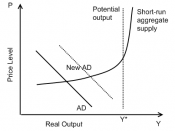Do Deflationary Gaps Self-Destruct?
Do deflationary gaps self-destruct? It is a complicated question to answer and before I can answer it I must explain exactly what a deflationary gap is and what its purpose in economics is.
A deflationary gap actually derives from an output gap and that is the difference between the actual level of activity in an economy, and the sustainable amount of activity given the capacity of the economy. An output gap is always given in a percentage form. It is possible for the output gap to be negative as well as positive and when the output gap is negative it is the equivalent to a deflationary gap. A positive output gap, which means that the economy is operating very fast and that aggregate demand is growing just as fast as inflation, is called an inflationary gap or an overheating economy.
An inflationary gap is a situation in which the aggregate demand (AD) of an economy is at an equilibrium level in excess of the full-employment level of output.
A deflationary gap occurs in the economy when the full employment level of income is more than the planned expenditure. The larger the gap the more unemployment and the more problems.
Before we continue it must be made clear that for several reasons it is impossible to gain zero unemployment because of several different reasons such as the fact that some people will choose to be unemployed. I am stating this because the words "full employment" will be used but it means that there are some people unemployed. Generally countries have a 5 percent limit and if employment is 95 percent or higher it is considered to be full employment. Also throughout the rest of this essay you will see letters such as Ye and Yf. Ye stands...


